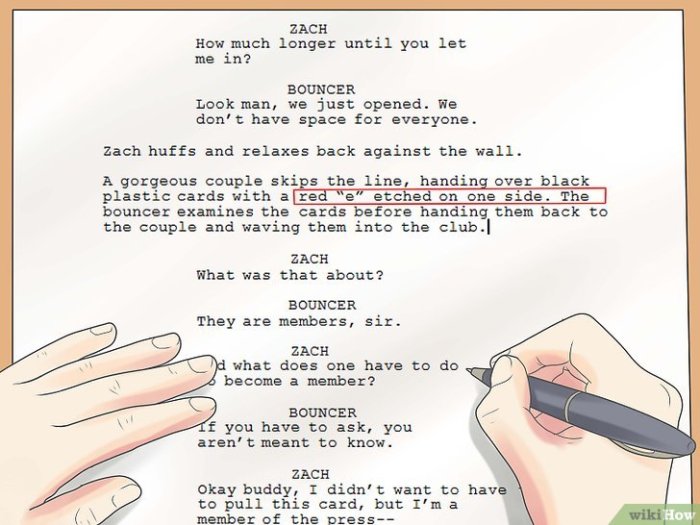Writing Video Scripts for Marketing dives into the art of creating captivating content that resonates with viewers, drawing them in from the get-go with an enticing blend of creativity and strategy.
As we explore the key elements and nuances of crafting video scripts for marketing, prepare to unlock the secrets to engaging your audience and driving conversions like never before.
Understanding the Basics of Writing Video Scripts for Marketing
Creating a well-crafted video script is essential for successful marketing campaigns. It serves as the backbone of a video, guiding the message and ensuring it resonates with the target audience.
Importance of a Well-Crafted Video Script, Writing Video Scripts for Marketing
- Establishes a clear message: A well-written script helps communicate the brand’s message effectively.
- Engages the audience: A script that is engaging and captivating can keep viewers hooked until the end of the video.
- Drives action: A compelling script can motivate viewers to take the desired action, such as making a purchase or signing up for a service.
Key Elements of a Video Script for Marketing
- Introduction: Grab the viewer’s attention and introduce the problem or need that the product or service addresses.
- Benefits: Highlight the key benefits or features of the product/service and how it can solve the viewer’s problem.
- Call to Action: Clearly state what action you want the viewer to take after watching the video.
Impact of Tone and Style on Marketing Message
The tone and style of a video script play a crucial role in shaping the overall marketing message. It sets the mood, conveys the brand’s personality, and determines how the audience perceives the message. Whether it’s a playful and light-hearted tone for a fun product or a serious and professional tone for a B2B service, the script should align with the brand’s image and resonate with the target audience.
Structuring a Compelling Video Script: Writing Video Scripts For Marketing
To create a compelling video script for marketing content, follow these steps:
Strong Opening
Start with a strong opening to grab viewers’ attention immediately. This could be a shocking fact, a thought-provoking question, or a compelling story that relates to your product or service.
- Introduce the problem: Clearly state the issue your product or service solves.
- Present the solution: Explain how your product or service can address the problem.
- Highlight benefits: Showcase the benefits and advantages of choosing your solution.
- Call to action: Encourage viewers to take the next step, whether it’s visiting your website, signing up for a free trial, or making a purchase.
Clear and Concise Script
When writing your script, keep it clear and concise to maintain the audience’s engagement throughout the video.
- Avoid jargon: Use simple language that anyone can understand.
- Focus on the essentials: Stick to the key points and avoid unnecessary details.
- Use visuals: Incorporate visuals to reinforce your message and keep viewers visually engaged.
- Include a compelling call to action: End the video with a clear and compelling call to action to prompt viewers to take action.
Incorporating Call-to-Actions (CTAs) in Video Scripts

It is crucial to include Call-to-Actions (CTAs) in video scripts for marketing as they prompt viewers to take specific actions after watching the video. CTAs help drive viewer engagement, increase conversions, and guide the audience towards the desired outcome, whether it’s making a purchase, signing up for a newsletter, or visiting a website.
Importance of CTAs in Video Scripts
- CTAs provide a clear direction for viewers on what steps to take next.
- They create a sense of urgency and encourage immediate action.
- CTAs help measure the effectiveness of the video in terms of viewer response and engagement.
Examples of Effective CTAs
-
“Click the link below to learn more”
-
“Sign up now for exclusive offers”
-
“Call now to speak with a specialist”
Placement Strategies for CTAs
- Place CTAs at the beginning to grab viewers’ attention right away.
- Include CTAs throughout the video to reinforce the message and increase the chances of conversion.
- End the video with a strong CTA to leave a lasting impression and prompt immediate action.
Optimizing Video Scripts for Different Platforms

When it comes to writing video scripts for different platforms, such as social media, websites, and YouTube, it’s essential to tailor your approach based on the specific requirements and audience preferences of each platform. Each platform has its own unique characteristics and audience demographics, so adapting your script to suit these differences can make a significant impact on the success of your video content.
Tailoring Scripts for Different Platforms
- For social media platforms like Instagram and TikTok, where content is consumed quickly and attention spans are short, it’s important to create short, snappy scripts that get straight to the point. Incorporating captions or text overlays can also help grab viewers’ attention as they scroll through their feeds.
- On websites, where viewers may have a bit more time to engage with your content, you can afford to delve into more detail and provide additional information. Consider including links or additional resources for viewers who want to learn more.
- YouTube, being a more long-form platform, allows for more in-depth content and storytelling. You can create longer scripts that provide valuable insights, tutorials, or entertainment for your audience. Including timestamps or chapters can help viewers navigate through longer videos more easily.
Adapting Scripts for Target Audience and Platform Requirements
- Understanding your target audience’s preferences, interests, and behaviors is crucial in crafting video scripts that resonate with them. Consider the tone, language, and messaging that will most effectively connect with your target audience on each platform.
- Take into account the technical specifications and best practices of each platform when writing your scripts. For example, ensuring your video is optimized for mobile viewing on social media platforms or incorporating s for on websites can enhance the visibility and reach of your content.
Customizing Scripts for Different Video Lengths and Formats
- When adapting scripts for different video lengths, prioritize the key messages and information you want to convey. For shorter videos, focus on delivering concise and impactful content, while longer videos allow for more detailed explanations and storytelling.
- Consider the format of your video content, whether it’s a tutorial, product demo, promotional video, or storytelling piece. Tailor your script to suit the specific format and objectives of your video, ensuring that the content aligns with the overall goals of your marketing strategy.





